At RSM, it’s important to us to create an environment where everyone can thrive. Monitoring and understanding our pay gaps is an important part of ensuring we are a diverse and inclusive firm. We report not only on our gender pay gap but also voluntarily on our ethnicity pay gap so that we can track progress and inform our people strategy.
Making meaningful progress
We want to make long-term change, and that requires a holistic approach. Rather than looking for short-lived gains, we seek to understand the root causes of our pay gaps and put in place sustainable solutions. We know that this kind of meaningful progress is challenging and will take time. But by continuing this focus, we are confident that we will achieve real, lasting results.
The pay gap explained
The pay gap is different to equal pay.
A gender and ethnicity pay gap is a measure of the difference between the average pay rates for men and women, and for ethnic minority and non-ethnic minority employees.
2022 pay gap results in summary
This year, our figures show:
- we have continued our progress to close our mean and median gender pay gaps;
- our gender bonus gaps have widened from 2021 – this continues to fluctuate from year to year; and
- there was an increase in our ethnicity pay and bonus gaps.
We are pleased to see continued progress in our gender pay gap results for 2022, but it's clear that overall, there is more work to do. The picture we are building year on year gives us increasing insight into where our attention needs to be focused.
We recognise that progress isn’t linear, and fluctuations in the makeup of our workforce and our application of our reward structures are to be expected. We will continue to report transparently, always working to improve the depth of data we capture and the tools and skills we use to analyse it.
We are already working to overcome challenges we face, such as the significant proportion of our people who choose not to declare their ethnicity. Incomplete data makes it difficult for us to build a truly accurate picture of our workforce, to understand the factors impacting our pay gaps, to take targeted action to address these gaps, and to monitor the effectiveness of our internal strategies and initiatives.
Statutory and voluntary pay gap reporting are useful tools that encourage scrutiny of, and action on, gender and ethnicity-related pay and bonus differences. While it may take time to see the impact of the steps we are taking now, we are confident that the foundations we are laying are moving us in the right direction.
Our ‘Grow Our Own’ strategy, for example, provides development support and opportunities to help individuals from all ethnicities and gender identities progress their careers within RSM – with ambition as their only limit. This strategy has led to our continued commitment to greater student recruitment, which is bringing in a larger, more diverse pool of talent with every year. We have also continued to foster a culture of agile, flexible working. Over time, we’re confident this will translate into greater diversity at senior levels and subsequently reduce our pay gaps.
We will continue to monitor and report on our pay gaps to ensure that, overall, we are on a positive trajectory. Monitoring our progress towards improving pay gaps is an important step in addressing them.
Explore our pay gap results in detail
- Gender pay gap
- Partner pay gap
- Ethnicity pay gap
Gender pay gap
Our 2022 figures show an improvement in our gender pay gap, giving us confidence that our diversity and inclusion (D&I) strategy is helping us progress steadily.
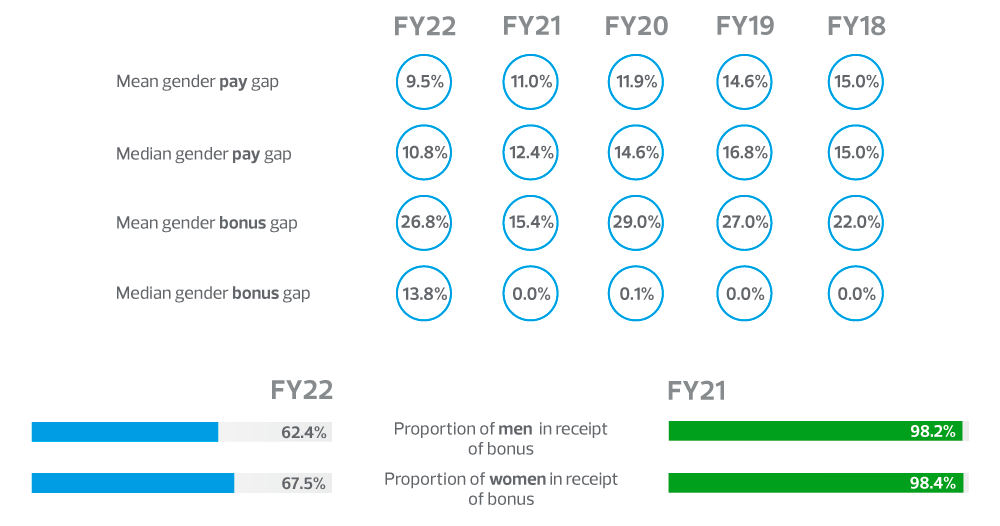
Lower representation of women in leadership roles, where remuneration is higher, contributes to our gender pay and bonus gaps. There is also a higher proportion of women in part-time roles in more senior positions, which also has an impact. To address our gender pay gaps, we continue to ensure our job adverts and recruitment and selection processes are gender neutral, and that through our ‘Grow Our Own’ strategy there are routes for our talented women to reach senior roles at RSM.
Despite marked progress on our gender pay gap, we have seen an increase in both the mean and median gender bonus gaps since last year. However, it is important to recognise the impact on our 2021 bonus gaps of the one-off flat rate ‘thank you’ bonuses, paid to the vast majority of our people, to acknowledge their extraordinary efforts during the height of the pandemic. When we remove the effect of the 2021 ‘thank you’ bonus and compare data on a like-for-like basis, we see a reduction in the gender bonus gap from 32.3% to 26.8%. It should also be noted that the difference between the proportion of men and women receiving a bonus remains a small one.
Proportion of men and women in each quartile pay band
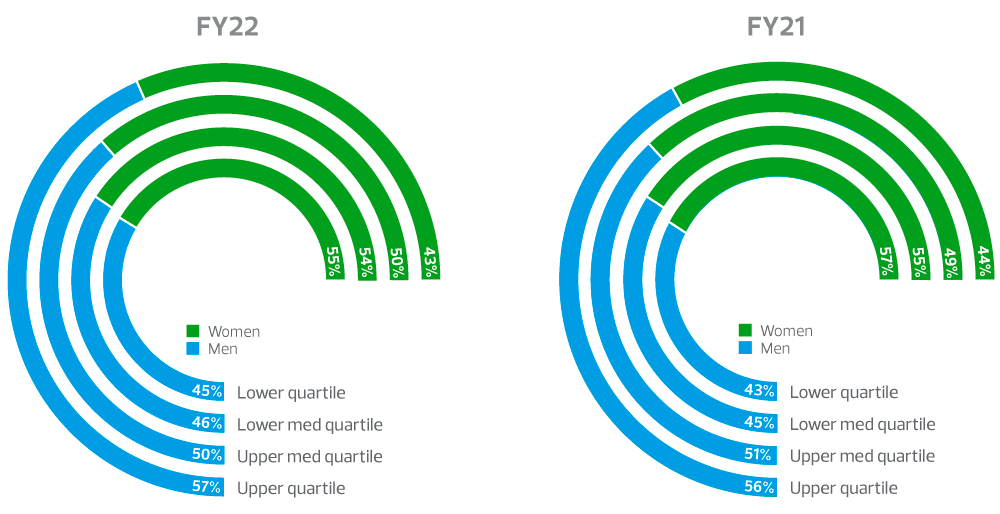
A contributing factor to our gender pay and bonus gap is the higher proportion of women than men who work part-time at RSM – something that is more prevalent at manager levels.
Partner pay gap
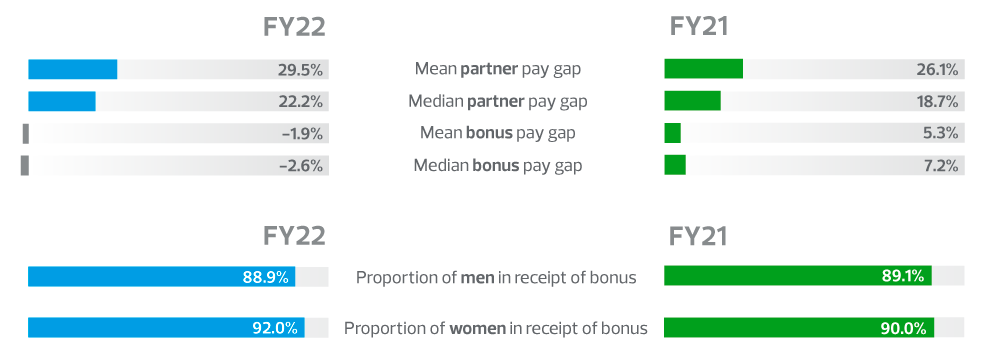
Our Partner mean and median gender pay gap figures show an increase in the period to April 2022, from 26.1% and 18.7% to 29.5% and 22.2% respectively. This is due to having proportionally more national partners who are men than women, where in the main, national partners awards tend to be higher than general partner counterparts. Our mean Partner bonus pay gap has significantly reduced once again, from 5.3% to -1.9%. Our median Partner bonus pay gap has reduced even further, decreasing from 7.2% to -2.6%. The proportion of women partners in receipt of a bonus increased year on year, from 90% to 92% – which remained higher than the number of male partners in receipt of a bonus, at 88.9%. We continue to support the career progression of our talented women into senior leadership and partnership roles.
Ethnicity pay gap
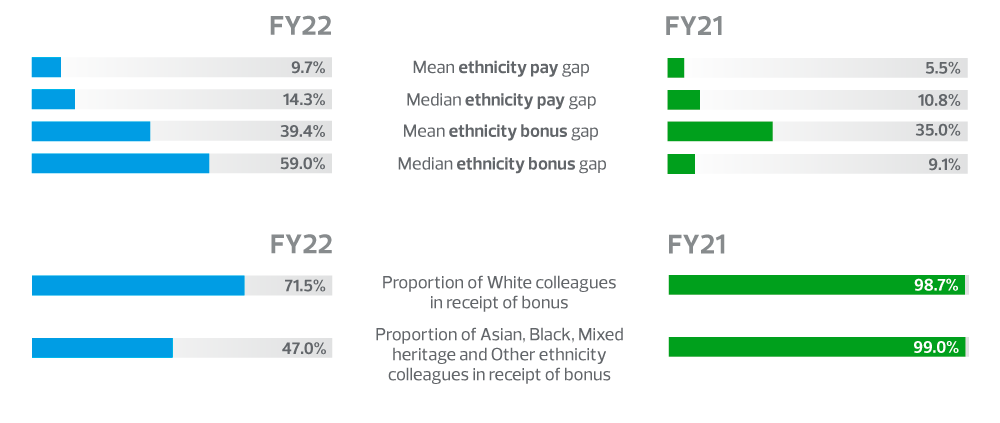
This is our third year of voluntarily reporting our ethnicity pay and bonus gaps. Over the last few years, we have had a focus on increasing the diversity of our trainee intake and creating opportunities within our profession, regardless of background. We are delighted that in 2022 37% of our annual trainee intake reported being from an ethnic minority background. Increasing diversity at more senior levels is, however, taking longer. This is due to a number of factors, including less vacancies at experienced levels when compared to our trainee intake, and a relative lack of diversity amongst experienced candidates within our profession as a whole.
Ethnicity recruitment intake figures

As well as performance and role-related awards, we give bonuses to our people to help them celebrate important life events, such as their wedding or civil partnership. Furthermore, we offer additional rewards to those who have done something notable, such as people who complete first aider training and exam prize winners. It is a requirement that these additional awards are factored into statutory calculations. Though employees from every background are eligible for these awards, the vast majority of recipients in the 12 months to April 2022 happened to be from white backgrounds – further skewing our results in this report.
In the year ahead we are continuing to focus on ensuring our people of all backgrounds have the developmental support they need to progress their careers and reach senior roles. We are also seeking to gain a fuller and more representative picture of our workforce by encouraging the 11.2% of our people who haven’t disclosed their ethnicity to do so.
The proportion of Asian, Black, Mixed heritage, Other ethnicities and White in each quartile pay band

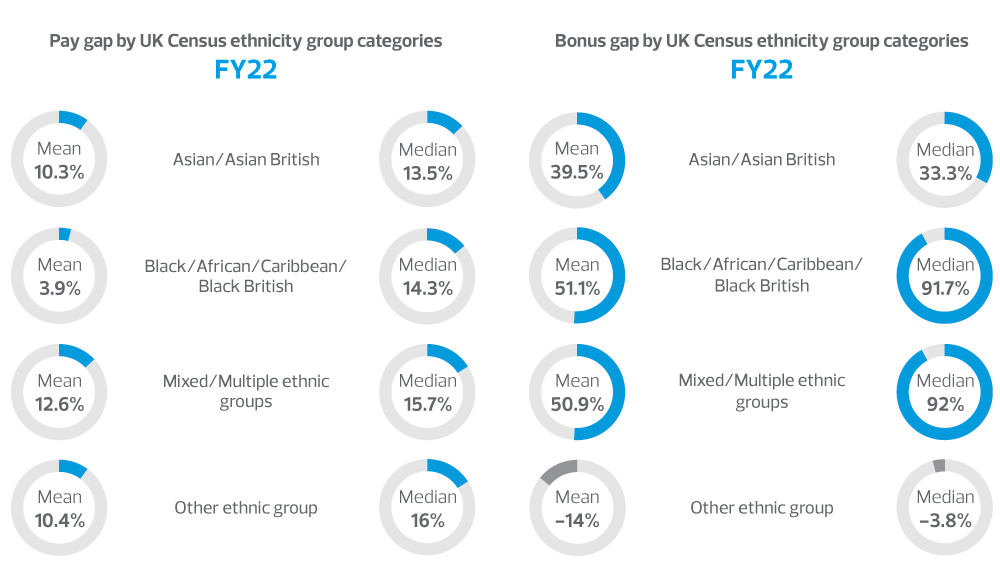
Reporting transparently
As part of our commitment to diversity and inclusion, we are constantly reviewing our approach to the depth of reporting. We encourage all our people to share diversity data, so that we can continue to make improvements that benefit everyone.
Our methodology
We are required to report our gender pay gap data for each separate legal entity that has at least 250 employees. We have therefore reported data for RSM UK Tax and Accounting Ltd and RSM UK Management Ltd. It’s important to us that we consider the picture for all employees, so figures in this report combine the data of both entities.
In addition to our employee pay gaps, we voluntarily report our partner pay gaps.
Current statutory pay gap calculations require us to exclude undisclosed ethnicities and declarations of gender identity that are not binary, ie, it includes only ‘men’ and ‘women’. Therefore, while we recognise and celebrate colleagues of all gender identities at RSM, we have had to exclude the following:
- 11.2% for non-disclosure of ethnicity
- 0.6% of employees because of their non-binary or undisclosed gender identity
Calculating the mean
We add up the rates of pay of all men, and the rates of pay of all women, and then divide these figures by the total number in each group. We then report the percentage difference between these two figures as our mean gender pay gap.
We repeat this process for ethnic minority employees and non-ethnic minority employees, and report the percentage difference as our mean ethnicity pay gap. The same methodology is applied in this report to show the difference between Black, Asian, Mixed heritage and Other ethnic minority employees and all White employees.
Calculating the median
We list rates of pay for every man and every woman, and we report the middle point of each list as the median. We then report the percentage difference between these two figures as our median gender pay gap. We repeat this process for ethnic minority employees and non-ethnic minority employees, and for each specific ethnic group, and report the percentage difference as our median ethnicity pay gap. Our bonus mean and median pay gaps are calculated the same way.




Gender pay gap information


Diversity and inclusion


Diversity and inclusion pay gap report 2021


